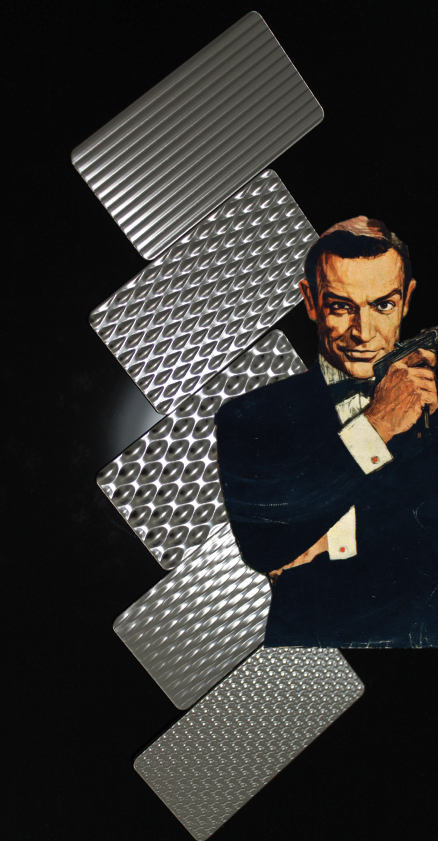Come per i grandi eroi della leggenda, la storia di Mr. Inox inizia ancor prima della sua apparizione, con una concatenazione di eventi che copre un arco di tempo lungo 162 anni. Tutto ebbe inizio quando due studiosi, scienziati e professori, scoprirono dei nuovi metalli che unendosi al ferro lo avrebbero reso più forte.
In tanti si applicarono con i nuovi ingredienti per raggiungere la formula perfetta: tutti provarono ad ottenere un metallo che resistesse all’azione dei più voraci acidi che il mondo conoscesse, anche se sarebbe stato sufficiente, almeno per iniziare, che non arrugginisse.
 Osservarono e testarono per tutto un secolo, qualcuno gioendo delle proprie intuizioni, qualcun altro fallendo, ma capendo, infine, che occorreva molto più Cromo di quanto avessero creduto, mentre bisognava rinunciare a un po’ di Carbonio.
Osservarono e testarono per tutto un secolo, qualcuno gioendo delle proprie intuizioni, qualcun altro fallendo, ma capendo, infine, che occorreva molto più Cromo di quanto avessero creduto, mentre bisognava rinunciare a un po’ di Carbonio.
Ci volle tempo e ci vollero gli uomini giusti: persone che riuscissero a vedere oltre ciò che già c’era, che sapessero immaginare, ma anche creare. Come il signor Baur, un fabbricante di Brooklyn che già nel 1865 impiegò i nuovi acciai, ancora imperfetti, nel settore della sicurezza, costruendo casseforti e barre per prigioni. [1]
Finalmente il 13 agosto 1913 Harry Brearley di Sheffield, Inghilterra, individuò la giusta proporzione tra gli elementi e una settimana dopo produsse la prima colata di acciaio inossidabile. Tra giugno e luglio del 1914 vennero fabbricati, grazie al suo contributo, i primi prodotti inox industriali. [2] Era nato, quindi, l’Inox, Mr. Inox, e con lui era iniziata l’era dell’acciaio inossidabile.
Col tempo migliorò anche il processo di produzione, così oggi se ne possono ottenere oltre 250 tipi, più puri e più puliti di quelli realizzati in passato, ma anche varianti con nuove finiture e nuove trame, come l’acciaio rigidizzato (si veda l’articolo “Le origini dell’inox rigidizzato”), l’acciaio colorato (si veda “Acciai inox colorati”) e gli acciai pinwheel (si veda “Acciaio inox rigidizzato 13SD: una trama unica”). Di conseguenza vennero aggiornati i sistemi di nomenclatura ed incrementati i campi di applicazione.
La storia di Mr. Inox, dopo più di un secolo dalla sua comparsa, non è ancora al suo epilogo, per fortuna!
Con la crescita della produzione dell’acciaio e la diversificazione del suo impiego si conferma e rafforza ogni anno l’ecosostenibilità dell’inox: con sempre più prodotti a basso consumo, bassissima manutenzione e lunga durata e avendo a disposizione più acciaio inossidabile da riciclare, diminuisce l’impiego di risorse energetiche e metallurgiche. Avendo più prodotti inox, sarà possibile produrre i nuovi manufatti utilizzando solo l’acciaio dismesso, senza produrre scarti[3] e senza dover estrarre nuove materie prime, risparmiando in termini di costi e di energia.
Insomma, ci aspetta un mondo più pulito in un futuro inossidabile!
ENGLISH VERSION:
As it happens for legendary heroes’ stories, the Mr. Inox’s adventure started long time ago, even before its appearance, about 162 years before that.
It all began with the discovery of new metals those make the iron alloys stronger. We are talking about Nickel and Chromium, found by two different scientists.
A lot of academics tried to use the new ingredients to develop the right formula: everyone was looking for an acid-resistant metal, but for the beginning it would have been enough one would not rust.
They observed, studied and tested all along a century, someone reaching success, some other going to failure, but at the end the scientific community understood the necessity of increasing chromium quantity and reducing carbon level.
It took time and right men: people able to see over the reality, capable of imagination with practical skills. In 1865, for example, the Brooklyn craftsman Mr. Baur used the new experimental steels to produce strongboxes and prison bars.
It was 13th august 1913 when finally, thanks to Harry Brearley from Sheffield (UK), the perfect composition was found. Brearley took only a week to produce the first stainless steel casting and then in the summer 1914 he helped with the fabrication of the first inox industrial products.
Mr. Inox was born, and with it the Stainless Steel Age began.
By the time the production process was improved, that’s why nowadays it’s possible to obtain more than 250 types of stainless steels, which are purer and cleaner than those in the past and with new finishes such as decorated, patterned, coloured and “Pinwheel”. The nomenclature system changed, and the areas of application increased and diversified.
The story of Mr. Inox, later over a century, is not finished, yet!
The growing stainless steel production and using highlight the environment-friendliness of Mr. Inox: making of stainless steel products is low-powered, they are very low-maintenance and long-lasting, in addition having more stainless scrap to recycle led to a significative reduction in searching of new energetic and metal resources.
More inox objects means going to a future with inox items created exclusively with recycled material, without waste and without mining new material, saving money and energy.
So, a cleaner world and a stainless future is waiting for us!
[1] Informazione tratta da Enduro. Acciai Inossidabili, FIAT – FERRIERE PIEMONTESI, 1955, p.
[2] Informazione tratta da 1913-2013. 100 years of Stainless Steel, Sheffield., a cura di Nancy Fielder, The Star, 2013, pp. 15, 29.
[3] Secondo i siti dell’ISSF e della BSSA, l’acciaio inox è riciclabile al 100% e non produce alcuna rimanenza. Nel 2013 il tasso di riciclaggio era vicino al 90%. 1913-2013. 100 years of Stainless Steel, Sheffield, a cura di Nancy Fielder, The Star, 2013.

Be First to Comment